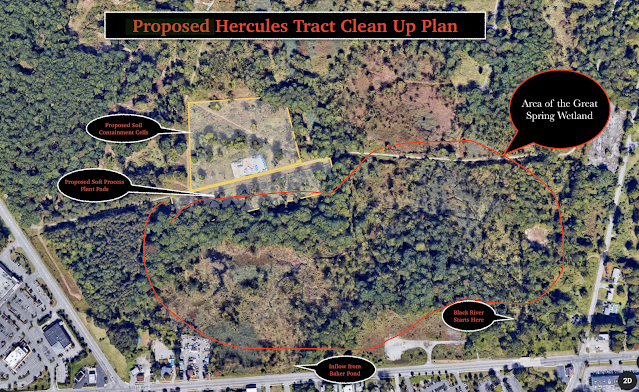I know a forgotten place where some of New Jersey’s purest cool water springs from deep underground. And now it may be threatened.
So where is this environmentally important spring? It is at the Southernmost edge of the former Hercules Powder property along U.S. Route 46 in Kenvil, New Jersey. You drove past it without notice if you ever traveled on Route 46 in Roxbury between Mine Hill and Ledgewood. Its outlet is literally across the highway from an IHOP Restaurant.
And why is the Great Spring a forgotten place? For over 150 years the spring has been an inconvenient appendage on 1,000 acres of privately owned industrial land where TNT and other explosives were manufactured. The spring’s wetlands have remained off-limits to the public and its ecology and geology have never been properly studied. A review of the New Jersey Highlands Environmental Inventory from 2013 suggests that the spring was not explicitly considered. And while everyone knows the former Hercules Powder property is a major pollution site, there is little public information on the extent of the contamination or the threats it may pose to the spring or the important aquifer below from which this water rises.
We do know that the now-abandoned Hercules property is laden with toxic chemical waste products from its bygone manufacturing days. We know there are acres of soil laced with PCBs, the by-product of burning chemical waste and other debris on-site. We know that the toxic chemicals used in the manufacturing of explosives still remain in some pipelines which run under buildings that haven’t been demolished yet. We know that some of these chemicals have contaminated the surrounding soil to an unknown extent and that these contaminants have migrated over the land and polluted surface waters in other places around the country where TNT was manufactured. Most of these sites, including several former Hercules plants in New York, New Jersey, California, and elsewhere, are designated superfund sites.
This Hercules property would qualify as a superfund site, but that was not the option the New Jersey DEP chose. In 2009, the Site Remediation Reform Act gave the DEP the power to allow private corporations to conduct all remedial activity on contaminated sites in New Jersey under the Department's scrutiny. The State also created Licensed Site Remediation Professionals (LSRP) to assure the work is completed under DEP guidelines. Under this arrangement, Ashland Global Properties, who bought the Hercules tract after the company went out of business, hired the WSP Corporation to conduct the cleanup back in the 1970s. The work was begun but never completed. The LSRP responsible for the cleanup recently changed hands and a new company is now in charge of the work. Activity on the site is back underway.
In the decades since Hercules shut down, public awareness of the pollution on the site and progress in cleaning it up has faded. Few know that the underground aquifer and spring that surfaces on the Hercules site is the source of the Black River, an important link in the Raritan River system that provides drinking water for 1.8 million people. Numerous commercial well fields also tap this same aquifer to supply municipal drinking water to many towns in the region.
 |
| A depiction of the aquifer that runs under the Succasunna Plains from the 1996 U.S. Geological Survey Water Resources Investigation Report |
Since November of 2021, the remediation process accelerated under a new corporation and the new LSRP. The Roxbury Planning Board approved two work permits, and earth moving equipment is on-site taking down trees, removing PCB contaminated soil, and bringing in clean fill to replace it. A bioremediation staging area is being built where other chemically contaminated soil will be brought and be microbially composted. The soil will be held in six large “pods” and seeded with a bacterium that breaks down the chemical components of TNT. The process is expected to take about six years.
A map showing the location of the soil remediation pods was presented at a public meeting in Roxbury last November. Of the more than 800 acres of land on which these bioremediation pods could be located, the map appears to show the staging area directly beside the Great Spring wetlands. The rationale for this decision or any mention of the spring was apparently not discussed at the meeting.
 |
| Google Earth image of the southern end of the Hercules property showing the approximate location of the proposed bioremediation site relative to the Great Spring wetlands |






























